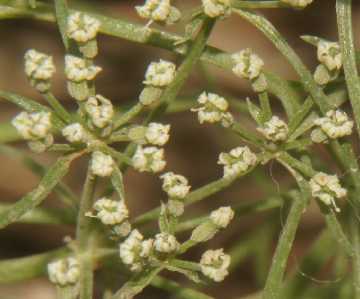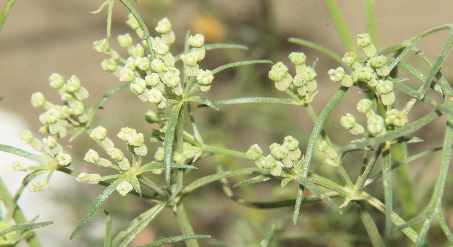
|
|
Cumin plant with young umbels (perhaps)
|

|
|
Cumin umbel with flowers closed (perhaps)
|
Cumin is a spice most popular all over the world, especially
in Latin America, North Africa and all over Asia, but least so in Europe,
although it had been a common spice in the times of the Roman Empire (see
silphion for more details on Roman cookery). Today,
cumin usage in Europe is restricted to flavouring cheese in the Netherlands
and in France; see also
blue fenugreek about
cheese and cheese spices.
Cumin is one of the most typical spices for India, both in the North and in the South.
Particularly in the North, fruits are used as a whole, and are fried (frequently together with
onion) or toasted before usage. A simple example to illustrate the
principle is alu jira [आलू जीरा],
boiled potato which is cut into slices and fried together with cumin till it is somewhat browned and crisp.
Legumes are always always flavoured with cumin in Northern India, typically by some sort of refrying the boiled
legumes with fat and spices (see ajwain for details on tarka [तड़का]),
but in the Himalayan rim and in Nepal, the cumin may be simply cooked with the pulses.
Cumin is also needed for the marinades that prepare meats for a short but intense broiling in the North-West Indian
clay oven tandur [तंदूर].

|
|
Cumin umbel with flowers closed (perhaps)
|
Ground cumin cannot be toasted, as it would char quickly, but toasted cumin can be ground and used as a
seasoning, as it needs no further heat-treatment; for example, the North Indian yoghurt salad
raita [रायता]
is often sprinkled with such toasted cumin, and it is sometimes employed in salty yoghurt drinks
(namkin lassi [नमकीन लस्सी], see rose for more)
Almost every North Indian curry or braising dish starts with spices being fried in fat, often together with onion (see there for details on the procedure); it is possible to use ground cumin for that purpose, but then it must be added after the onions to prevent burning.
The only regions in India where cumin is not used are the tribal areas in the North East, with the exception of Manipur where
cumin abounds in the local fish curries which have a somewhat Bengali appearance.
In South India, aggressively toasted spices are much loved, and cumin is one of the favourites, although coriander
appears slightly more popular. Both spices are often found in vegetable curries from Tamil Nadu or Karnataka; as an example, the potato
stuffing of the famous crèpe or flatbread masala dosa [மசால தோசை]
could be mentioned, or the flavouring of the spice broth called rasam [ரசம்]
(see tamarind for details).
South India has a slight preference for ground spices, and thus, cumin is optically less present than in the North;
for example, the signature food sambar [சாம்பார்],
a thin curry made from vegetables and pulses with the texture of a thick, creamy Western soup, is intensively
flavoured with a spice mixture called
sambar podi [சாம்பார் பொடி],
which consists of a number of separately toasted spices that are ground together to a fine powder
(see coriander for more).
In Sri Lanka, located South of India, cumin takes priority over coriander; it puts a specific mark on many of the
coconut-based meat and vegetable curries that island is famous for; I found the strongest cumin flavour in beef curries.
In Sri Lanka, curry spices are always toasted to a very dark colour, which gives the Sri Lankan curries their particular character.
The fragrance of toasted cumin, typically in combination with coriander, is the most characteristic impression from Sri Lankan cuisine
(and to some extent, South Indian also)! Yet, many Sri Lankan cooks do not toast their spices themselves, but rely on curry powder from the market
(Sinhala tunapaha kudu [තුනපහ කුඩු],
Tamil karittul [கறித்தூள்]
or masala tul [மசால தூள்]).
However, this curry powder has little in common with the Anglo–Indian product of the same name (see curry leaves).

|
|
Cumin leaves are tripartite but should be more filiform (perhaps)
|
There are no curry powders in India, at least not in the Westener’s sense; nevertheless, Indian cooking uses a lot of spice mixtures,
some of whch have a reasonably fixed composition; almost all of them contain cumin. In South India, particularly Tamil Nadu, there is sambar podi
(see coriander), a mix of toasted legumes and toasted spices, mostly cumin and coriander; it is
used for vegetarian foods only. Another South Indian spice blend is
bisi bele pudi [ಬಿಸಿ ಬೇಳೆ ಪುಡಿ],
used in Karnataka for certain rice dishes (see coconut). That state also has a simpler formulation that is usually just referred
to as pudi [ಪುಡಿ], meaning powder
;
it is used as a hot and nutty table condiment.
In Southern Nepal, Bengal, Bangladesh and parts of North East India, there is a spice mix called panch phoron
[পাঁচ ফোড়ন] five spices
which flavours vegetable and fish curries of that regions.
Morover, there is hardly any baghar [बघार]
nor tarka [तड़का]
in India that does not contain cumin (see onion and ajwain, respectively, for more information).
North India has a spice mixture with varying composition but a fixed name: Garam masala [गरम मसाला, گرم مسالحہ or گرم مصالحہ].
That name means hot spice
, indicating that the component spices are believed in Indian medicine to provide heat to the body and warm it; the name does not imply hot
in the sense of spicy
. Garam masala may contain almost any Indian spice; typically, it combines warm, earthy notes (cumin, coriander, occasionally fenugreek; all of these lightly toasted) with aromatic spices (Indian bay-leaves, cloves, cinnamon, cardamom) and a dash of black pepper, but chile is not used (unless in Maharashtra).
Whatever the exact composition is, the components are simply ground together to yield garam masala.

|
|
Cumin leaves are tripartite but should be more filiform (perhaps)
|
Very simple versions of garam masala emphasize the warm–earthy components are are sometimes known as
dhaniyajira [धनियाजीरा] coriander–cumin
,
because they contain hardly anything else.
Yet the Moghul-inspired mixtures (muglai garam masala) follow the opposite path and have the aromatic spices increased in proportion (often adding nutmeg,
which is otherwise rare in India); in the extreme case, the mixture might contain no cumin nor coriander at all.
Further regional preferences include the preponderance of black cardamom in Rajasthan and a South Indian adaption Kerala,
which includes star anise.
All the different spice mixtures summarized as garam masala
are used finely ground, and it is common to see them sold on the market as a ready-to-use powder. While it is common to add garam masala late in the cooking process,
often just before serving, it can be added at to the food in earlier stages of preparation, thereby influencing its flavour more deeply.
Black cumin is the fruit of a related plant that
grows wild in Iran, Tajikistan and the Northern Indian region Kashmir. It exhibits a strong,
earthy flavour somewhat reminiscent of cumin; the Moghul cooking style of North India has a weak
preference of black cumin over regular (or white
, as it is called to stress the contrast) cumin,
but this only holds for recipes in which no frying or toasting of cumin is prescribed.

|
|
Close-up to cumin flowers: The petals are markedly inward-curved (perhaps)
|

|
|
Cumin umbel with open flowers (perhaps)
|
Cumin is also very popular in Western to Central Asia;
spice mixtures from this region featuring cumin are the Yemeni zhoug condiment paste (see coriander), Saudi-Arab
baharat (see paprika) and Georgian spiced salt mixture
svanuri marili (see garlic).
Cumin is a common flavouring for Arabic style dishes.
It is typical for the stew tagine (also tajine [طاجن]) of
Arab-influenced Northern Africa, and is commonly contained in commercial cous-cous spice mixtures.
Other Arabic specialities with cumin are hummus [حمص],
a paste made from chickpeas, olive oil and sesame,
and falafil (also felafel or falafel [فلافل]).
The latter are small balls made from ground legumes (chickpeas, often with some fava beans mixed in) and
flavoured with garlic and cumin; they are deep-fried and eaten as a snack.
The Sudanese version of that dish, tamiyah [طعميه],
is based on fava beans alone and has a less refined, more rustic and very pleasant flavour.

|
|
Cumin umbel with open flowers (perhaps)
|
In South Eastern and Eastern Asia, cumin is less valued but used occasionally;
cumin is, though, very important for Burmese cooking (see onion on the topic or Burmese curries) and it does
play a rôle in the cooking styles of Thailand (see coconut on the subject of Thai curries) and Indonesia.
Cumin is important in the cuisine of the Uighurs (Chinese province Xinjiang [新疆]),
which, however, cannot be considered Chinese cookery in historical sense. Uighuri
skewered meat grilled over charcoal is now available all over China and has
become rather popular as yang rou chuan [羊肉串].
In China proper, cumin is a rare spice used only for a small number of recipes, for example in
ziran niurou [孜然牛肉]
from the Hunan [湖南] province:
Thin slices of beef are fried together with cumin, chile and garlic
in a wok and served with scallion and sesame oil.
In Central and South American cooking, cumin plays is now an important spice,
although it tends not to dominate the cuisines in the same way as the native New World spices.
It is found, from México to Perú, as component in spice blends (e. g. in
Mexican mole sauces (see paprika),
but it is generally used in moderation and, thus, does not put its stamp onto the food
as ist does in many parts of the Old World.













